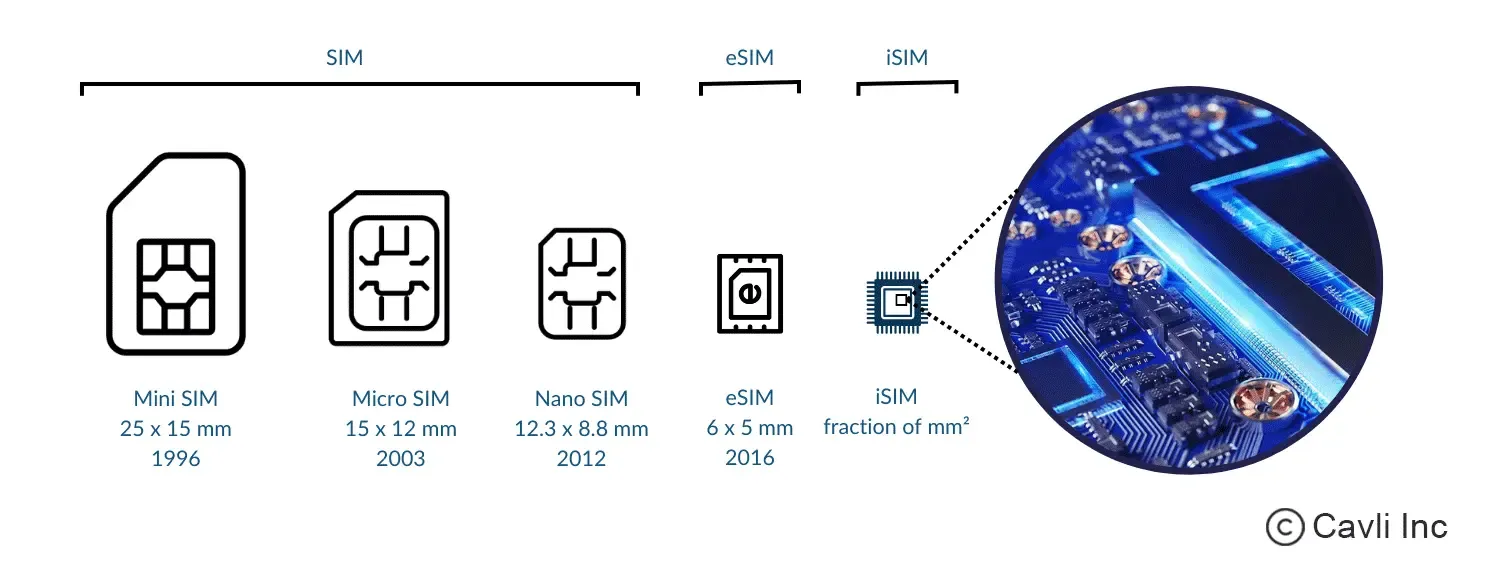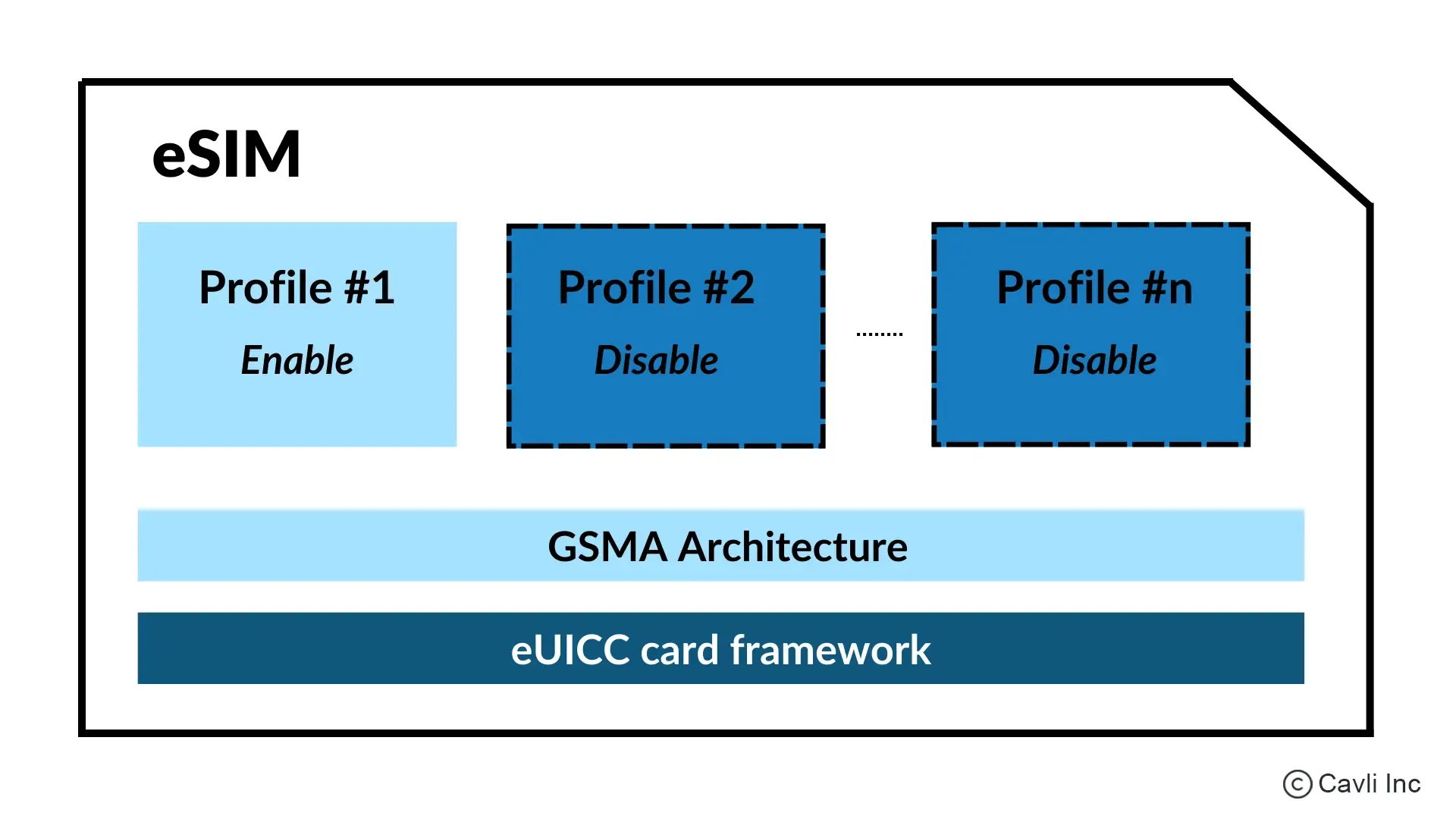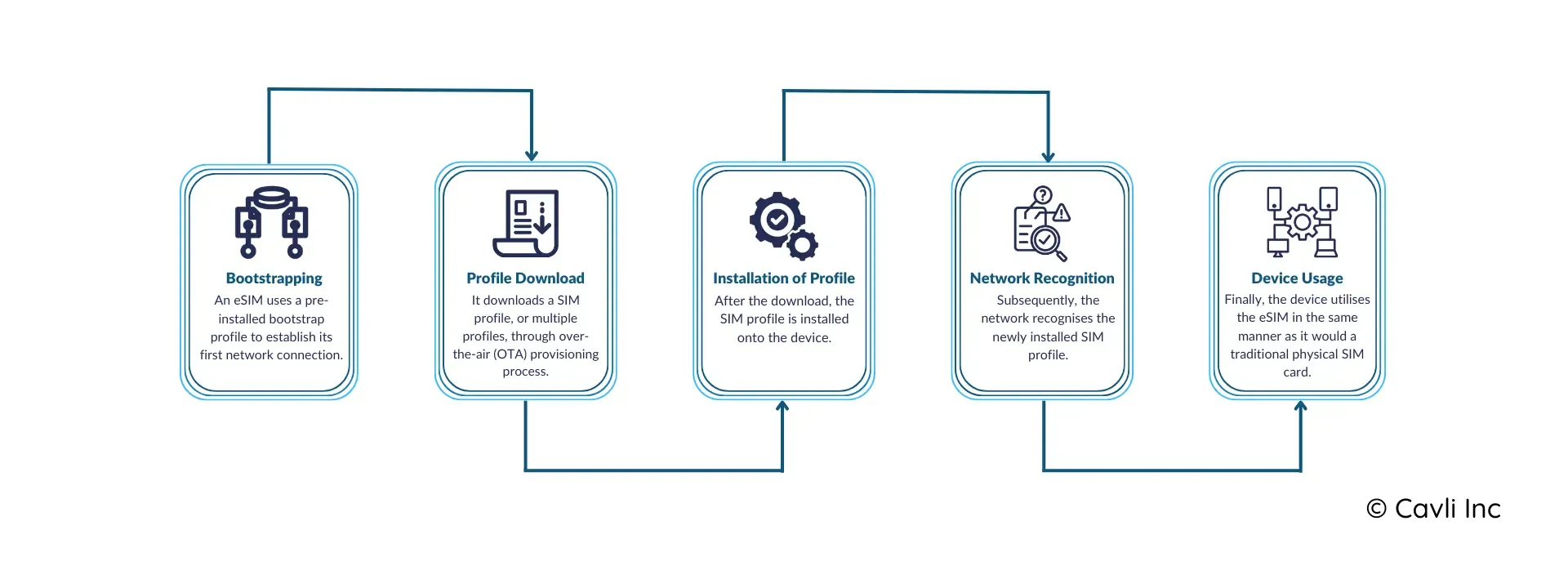In this rapidly evolving field of mobile technology, SIM (Subscriber Identity Module) cards identify users, confirm device legitimacy, and safeguard data.
With advancements in connectivity technology, Embedded SIMs have become the preferred technology for IoT-enabled devices in today's market. This advanced technology, replacing traditional physical SIM cards, offers significant advantages to IoT end-users, original equipment manufacturers (OEMs), and innovative solution providers. Notably, eSIMs facilitate easier device connectivity and management, a crucial factor driving their widespread adoption in the IoT sector.
What Is An eSIM?
An eSIM, or Embedded Subscriber Identity Module, is a type of SIM card integrated directly into a device, eliminating the need for a physical SIM card and slot. This technology allows for over-the-air provisioning of mobile services, making it possible to switch carriers or service plans remotely without physically changing the SIM card. Ideal for devices across various sectors including IoT and consumer electronics, eSIMs facilitate seamless network connectivity and enhance device design by saving space.

The eSIM revolutionizes device connectivity, offering a digital, soldered alternative to traditional SIM cards. This technology enables seamless cellular network connections through over-the-air (OTA) remote provisioning, supporting multiple carrier profiles and software updates. Ideal for IoT (Internet of Things) and M2M (Machine-to-Machine) communications, eSIMs facilitate continuous connectivity across various devices, including smart meters, connected cars, smartphones, tablets, and smartwatches. They enhance operational efficiency and security by allowing remote network policy management without physical device access.
Juniper Research Report forecasts that eSIMs installed in connected devices will increase from 1.2 billion to 3.4 billion in 2025, representing a growth of 180%.
eSIM technology benefits IoT users, OEMs (Original Equipment Manufacturers), and solution providers by offering secure and robust connectivity solutions with reduced size and lower power consumption. It's poised for significant growth in the IoT sector, driving business-to-business innovation and engagement.
The Transitioning From Conventional SIMs To eSIMs
A traditional SIM card is a physical entity inserted into mobile phones or other machine devices to initiate network connectivity. It is a detachable module made of silicon and copper, housed in a plastic shell uniquely identified by a globally exclusive serial code known as an ICCID (Integrated Circuit Card ID) number.
In addition, it contains an IMSI (International Mobile Subscriber Identity), an automatically generated code used to authenticate a device with the mobile network when the device is switched on.
Usually, SIM cards contain a single IMSI code, however, there are specific SIM cards that support multiple IMSI and it is necessary to check with the mobile operator to gain surety of this capability. The usage of multiple carriers on one SIM card might also limit certain services or special tariff benefits offered by mobile network operators.
Deploying conventional SIM cards in the IoT industry has undergone significant drawbacks, making it difficult for the end user to channel the flexibility and ease of operation.
What is the Difference between an eSIM and a Physical SIM card?
| Feature | eSIM (Embedded SIM) | Traditional SIM Card |
|---|---|---|
| Size | Much smaller, does not require physical space for a SIM slot. | Larger, requires a physical slot in the device. |
| Flexibility | Can store multiple carrier profiles; easy to switch carriers remotely. | Supports only one carrier profile at a time; requires physical swapping for changes. |
| Durability | More durable due to lack of moving parts and external slots. | More prone to damage and wear due to physical handling. |
| Provisioning | Remote provisioning and management of carrier profiles. | Manual insertion and removal for provisioning. |
| Mobility | Facilitates automatic profile switching across multiple local networks without changing SIM cards. | Requires physical SIM swap when changing networks. |
| Environmental Resistance | Better resistance to harsh conditions due to embedded design. | More exposed to environmental factors due to physical slots. |
| Cost Efficiency | Potentially more cost-efficient in the long run due to remote management. | May incur additional costs for physical SIM cards and swapping. |
| Security | Enhanced security features due to integrated design and remote management. | Physical security depends on the device's SIM slot design. |
Evolution Of SIM Form Factors

eSIM technology is standardized by GSMA, ETSI, Global Platform, and SIMalliance. Their collaborative efforts ensure that eSIM technology is robust, secure, and interoperable.
- Full-Size (FF1)
- Mini-SIM (FF2) 25mm x 15mm x 0.76mm
- Micro-SIM (FF3) 15mm x 12mm x 0.76mm
- Nano-SIM (FF4) 12.3mm × 8.8mm × 0.67mm
- Embedded SIM or eSIM (MFF2) 5mm x 6mm x 1mm
- iSIM
- SoftSIM
The evolution of SIM form factors in IoT devices reflects a journey toward efficient power consumption and adaptability. Initially, IoT devices utilized standard SIM cards, similar to mobile phones. However, as the need for compact and more integrated solutions grew, the industry shifted towards Micro-SIM and then Nano-SIM, each step reducing size and allowing for more compact designs.
Embedded SIM was introduced as the MFF2 format, a major step in miniaturization and integration. This evolution continued with the Wafer Level Chip Scale Package (WLCSP) and further advanced led to the development of the MFF-XS.
The latest in this line of evolution is the integration of SIM functionality directly into the device's processor, known as the integrated SIM or iSIM.
Qualcomm Technologies, Inc. and Thales have jointly revealed the world’s first GSMA-certified Integrated SIM (iSIM) on the Snapdragon® 8 Gen 2 Mobile Platform. This innovation is groundbreaking in consumer electronics where smartphones can incorporate SIM functionality directly in their primary processor.
SoftSIM is the futuristic SIM solution to go virtual where SIM functionality can be delivered in code format, eliminating the need for physical components for provisioning SIM profiles.
Evolution Of SIM Technology Over The Past Years

Factors Influencing eSIM Adoption In IoT Applications
Popularity Of Connected Devices

The eSIM market value is expected to grow to 16.3 billion US dollars by 2027. With the exponential growth of connected IoT devices, eSIMs provide a sleek and compact design that is well suited for applications like wearables, smart home applications, and for OEMs for designing new solutions.
Demand For Streamlined Connectivity

As consumers and businesses increasingly expect uninterrupted and hassle-free connectivity, eSIMs offer an attractive solution. They allow for easy switching between network providers and plans, catering to the need for flexible and efficient connectivity.
Adoption from Relevant Industry Players

The GSMA Intelligence report revealed that 90% of mobile operators are expected to offer eSIM services by 2025. Major OEMs and telecom operators are increasingly integrating eSIM technology into their offerings. This adoption by key industry players not only validates the technology but also encourages its widespread use, further driving the market growth.
Need For Cost Optimization

eSIMs eliminate the need for multiple physical SIM cards, simplify logistics and reduce the total ownership cost of connected devices. It is beneficial for businesses engaged in fleet management and asset tracking systems covering a global landscape.
Need For Diversifying Revenue Channels

Service providers are embracing eSIM technology as a means to diversify their revenue streams. By offering eSIM services, they can tap into new customer segments, and create additional value-added services.
Increased Focus On Global Connectivity

The active eSIM connections are expected to grow by 1400%, resulting in more than 4.5 billion connected devices by 2027. The eSIM technology is particularly advantageous to connect to local networks around the world without changing SIM cards. It is crucial for global IoT applications, where seamless cross-border connectivity is essential.
How Does An eSIM Work?

eSIMs with multiple operator profiles are upgraded over the air. Profiles are downloaded and managed via a secure internet connection. Upon reaching its destination, the eSIM automatically initiates a process called bootstrapping, where it connects to the most appropriate network operator.
The device gains authorization to access the network. In this arrangement, the service charges are borne by the business or device owner, ensuring a seamless and efficient connectivity experience. Activation and setup of eSIMs are done digitally, and users can switch carriers or plans by downloading a new carrier profile to the eSIM.
Steps Involved In Activating An eSIM

- Bootstrapping: An eSIM uses a pre-installed bootstrap profile to establish its first network connection.
- Profile Download: It downloads a SIM profile, or multiple profiles, through over-the-air (OTA) provisioning process.
- Installation of Profile: After the download, the SIM profile is installed onto the device.
- Network Recognition: Subsequently, the network recognizes the newly installed SIM profile.
- Device Usage: Finally, the device utilizes the eSIM in the same manner as it would a traditional physical SIM card.
Download Now: The Future of eSIM for IoT Solutions
Impact of eSIM Technology Across Industries
Automotive Innovations with eSIMs:
In the automotive industry, eSIMs are key to the next generation of connected vehicles. They facilitate enhanced telematics services, such as real-time diagnostics and automated emergency calls, improving both vehicle functionality and passenger safety. For example, a leading automotive manufacturer has recently adopted eSIM technology to enable global connectivity in its vehicle fleet, ensuring constant updates and seamless communication.
Revolutionizing Healthcare with eSIM Technology:
In healthcare, eSIMs are instrumental in advancing patient care through wearable technologies. These devices transmit critical data to healthcare providers in real-time, allowing for immediate responses in emergency situations. The integration of eSIMs into medical devices exemplifies how connectivity can directly enhance patient outcomes and streamline medical processes.
eSIMs Driving Smart City Development:
Smart cities benefit significantly from eSIM technology. eSIMs provide the backbone for IoT networks that manage everything from traffic lights to water systems, offering a new level of efficiency and environmental monitoring. A notable implementation has been in the management of public transportation, where eSIMs ensure continuous communication and system updates.
Learn More: Top 7 IoT Applications in 2024
Benefits of eSIM Technology
Advanced Embedded Design:
The eSIM technology has evolved significantly, with advancements leading to even smaller component sizes. This enhanced design increases durability and reduces power requirements, which is crucial for devices where battery life is a top priority. The compact nature of eSIMs is particularly beneficial for high-tech wearables and remote sensors, where both space and efficiency are critical.
Enhanced Remote Provisioning:
One of the major benefits of eSIM technology is its refined remote provisioning capabilities. The adoption of more secure and efficient algorithms has improved the management of IoT devices on a global scale. Recent regulatory changes have further simplified international device management. Comprehensive Remote SIM Provisioning (RSP) solutions now feature advanced eSIM operating systems and the IoT SAFE ecosystem, which contribute to a more robust and secure device root of trust.
Expanded Carrier Profile Support:
eSIM technology supports a broader range of devices due to the global adoption of the GSMA's expanded specifications, SGP.31/32. This enhancement allows for smoother transitions between network operators and improves network management. The flexibility provided by eSIMs is particularly advantageous for IoT applications, where reliable and adaptable connectivity is essential.
Upgraded Security Features:
The latest eSIMs come equipped with advanced security protocols, including superior encryption and authentication methods. These upgrades help address evolving cybersecurity threats, ensuring that eSIMs are less vulnerable to tampering, physical theft, or unauthorized access. As a result, eSIMs offer enhanced protection for sensitive data across connected devices, contributing to overall better security in a connected world.
Future Developments in SIM Technology
Integrated SIM (iSIM):
Integrated SIM, or iSIM, represents a significant leap forward by embedding SIM functionality directly into a device's processor. This innovation offers substantial benefits in terms of space efficiency and resource optimization, making it particularly advantageous for IoT devices and applications. By integrating eSIM technology directly into the chipset, manufacturers can design more compact and streamlined devices while enhancing security. iSIM technology, compliant with GSMA standards, simplifies device design and boosts operational efficiency, thus positioning itself as a game-changer in the connectivity landscape.
SoftSIM:
SoftSIM advances the concept of virtualization by providing SIM capabilities entirely through software. This development eliminates the need for physical eSIM cards, enabling users to switch carriers or plans virtually and effortlessly. SoftSIM technology offers flexibility and convenience, especially beneficial for dynamic and adaptable connectivity solutions. By virtualizing the SIM function, softSIM facilitates improved remote provisioning and management of connected devices, paving the way for enhanced user experiences with seamless network connectivity.
Conclusion
Unlock The eSIM Capabilities For Heightened Operational Efficiency
The adoption of eSIM technology in the Internet of Things (IoT) industry marks a significant evolution, offering flexibility and global scalability. eSIM technology is ideal for devices deployed in remote or hard-to-reach locations. The inherent robustness and compact size of eSIMs make them suitable for a wide range of IoT-enabled devices from wearables to industrial sensors.
Integrating eSIMs can significantly unlock the business potential of your solutions. eSIM modules are key enablers of uninterrupted connectivity in bulk IoT deployments. eSIM integration for IoT solutions can lead to significant improvements in connectivity management, device maintenance, data security, and overall cost-effectiveness, thereby enhancing the operational agility and competitiveness of businesses in this connected world.
Know more about eSIM-integrated Cavli C series modules for global IoT deployment.


